Philip Morris International Bundle
How has Philip Morris International Transformed Over Time?
Journey back in time to explore the fascinating Philip Morris International SWOT Analysis and the rich PMI history. From a single tobacco shop in 1847 London to a global powerhouse, the story of Philip Morris International is one of adaptation and evolution within the dynamic tobacco industry. Discover how this company, initially known for iconic cigarette brands, is boldly reshaping its future.
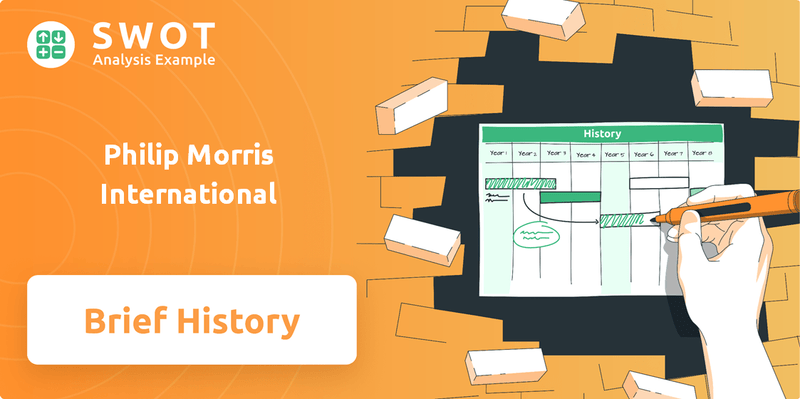
This exploration will delve into the company timeline, from its early days to its current position as a leader in smoke-free alternatives. Understanding the Philip Morris International company background is crucial for investors and strategists alike. The company's strategic shift is a testament to its resilience and forward-thinking approach in a changing market.
What is the Philip Morris International Founding Story?
The story of Philip Morris International (PMI) begins in 1847. That's when Philip Morris opened a tobacco shop in London, setting the stage for a global tobacco giant. This early venture, though not directly linked to the modern company, marked the initial steps in the PMI history.
Over the years, the company saw several changes. In 1881, Philip's son, Leopold Morris, partnered with Joseph Grunebaum. Later, William Curtis Thomson and his family took over. This period was crucial for the company's evolution.
The U.S. operations began in 1902 with Gustav Eckmeyer. The American business was later incorporated in Virginia in 1919, introducing the iconic Philip Morris coronet logo. By the end of the 1920s, the company started manufacturing cigarettes in Richmond, Virginia. This era coincided with significant shifts in industry and consumer behavior, which fueled the growth of tobacco companies.
Here's a look at some of the important events that shaped Philip Morris International.
- 1847: Philip Morris opens a tobacco shop in London.
- 1881: Leopold Morris and Joseph Grunebaum form a partnership.
- 1894: William Curtis Thomson and family take control.
- 1902: Gustav Eckmeyer incorporates the company in New York.
- 1919: The American business is incorporated in Virginia, and the Philip Morris coronet logo is introduced.
- 1920s: Cigarette manufacturing begins in Richmond, Virginia.
Philip Morris International SWOT Analysis
- Complete SWOT Breakdown
- Fully Customizable
- Editable in Excel & Word
- Professional Formatting
- Investor-Ready Format
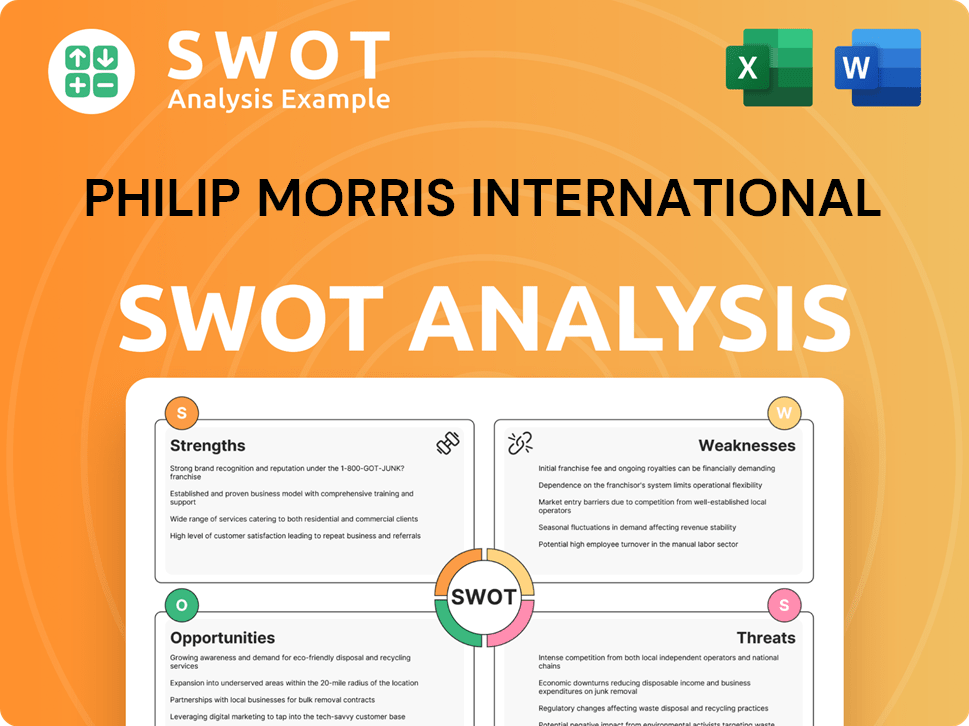
What Drove the Early Growth of Philip Morris International?
The early growth and expansion of Philip Morris International (PMI) before its spin-off was marked by significant international developments. This period laid the groundwork for its future as a global leader in the tobacco industry. Key milestones and strategic moves during this phase shaped its global footprint and brand recognition. This PMI history is crucial for understanding its evolution.
In 1954, Philip Morris (Australia) Ltd. was established, marking the first major affiliate outside the U.S. The rise of Marlboro as the world's top-selling cigarette brand in 1972 was a pivotal moment, fueling further international expansion. This success significantly boosted the company's global presence. These early moves were crucial for the company's growth.
In 1987, Philip Morris International (PMI) was formally incorporated as an operating company of Philip Morris Companies Inc. This focused on manufacturing and distributing products globally outside the United States. This strategic shift allowed for a more defined international focus. This was a key moment in the company timeline.
Acquisitions played a crucial role in PMI's expansion. The 1968 acquisition of Godfrey Phillips Ltd. provided access to tobacco markets in India, Pakistan, and New Zealand. The 1969 acquisition of Miller Brewing Co. demonstrated diversification beyond tobacco. These acquisitions helped shape the Philip Morris International company background.
In the early 2000s, PMI acquired PT HM Sampoerna Tbk in Indonesia and Compania Colombiana de Tabaco SA (Coltabaco) in Colombia. These acquisitions strengthened its position in key markets. The relocation of the operations center to Lausanne, Switzerland, in 2001, further solidified its international focus. The market reception during this period was generally positive, with the company benefiting from the global popularity of its brands. For more insights, you can read the article about the history of Philip Morris International.
Philip Morris International PESTLE Analysis
- Covers All 6 PESTLE Categories
- No Research Needed – Save Hours of Work
- Built by Experts, Trusted by Consultants
- Instant Download, Ready to Use
- 100% Editable, Fully Customizable
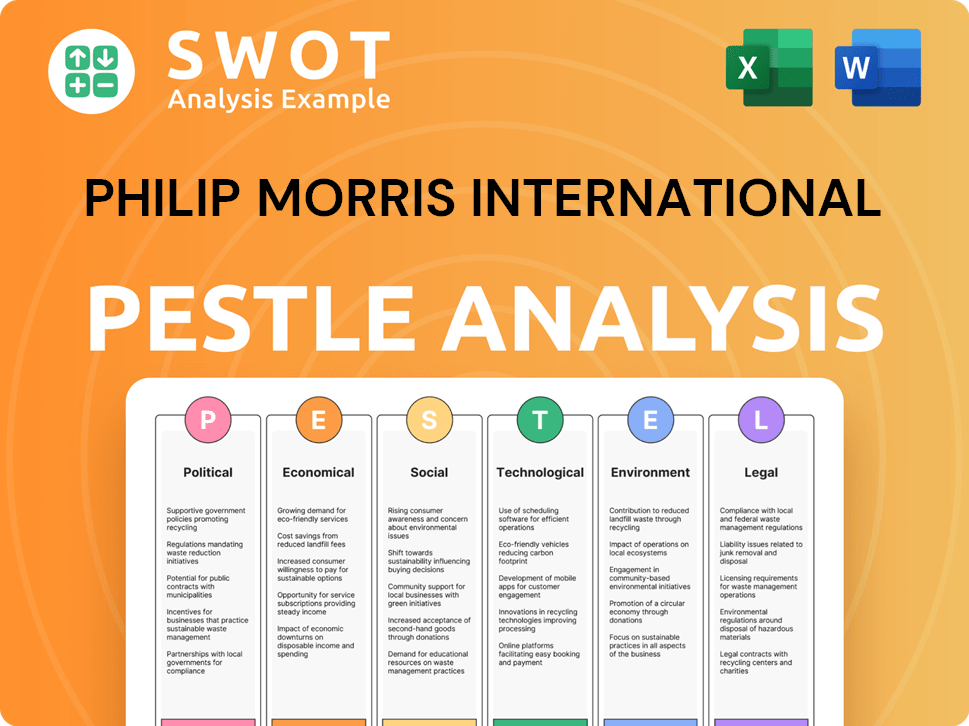
What are the key Milestones in Philip Morris International history?
The PMI history includes several key milestones that have shaped the company's trajectory in the tobacco industry. These events reflect a dynamic evolution, from traditional cigarette brands to a focus on smoke-free alternatives. This evolution is a key aspect of the Philip Morris International company background.
| Year | Milestone |
|---|---|
| 2008 | PMI initiated its strategic shift towards smoke-free products, investing over $14 billion in research and development. |
| 2014 | The company launched IQOS, its first heat-not-burn product, in Italy and Japan, marking a pivotal move towards reduced-risk products. |
| 2022 | PMI acquired Swedish Match, a leader in oral nicotine delivery, expanding its smoke-free portfolio. |
| 2024 | By the end of 2024, PMI's smoke-free products were available in 95 markets, used by an estimated 38.6 million adult users. |
Philip Morris International has consistently pursued innovation to adapt to changing market demands. A significant innovation was the development and commercialization of IQOS, a heat-not-burn product, which has gained substantial market share. This focus on innovation is a core part of the PMI history and its strategic direction.
The introduction of IQOS in 2014 represented a major shift in the tobacco market, offering a reduced-risk alternative to traditional cigarettes.
PMI's investment in heat-not-burn technology has been a cornerstone of its transformation, with IQOS commanding a significant portion of the global market.
The U.S. Food and Drug Administration (FDA) authorized versions of PMI's IQOS devices as Modified Risk Tobacco Products, a significant regulatory achievement.
PMI has expanded its smoke-free product portfolio to include brands like VEEV and ZYN, diversifying its offerings beyond heated tobacco.
The acquisition of Swedish Match in 2022 further bolstered PMI's smoke-free portfolio and diversified its product offerings.
By the end of 2024, PMI's smoke-free products were available in 95 markets, demonstrating its commitment to global expansion.
Philip Morris International has faced several challenges, including the decline in cigarette sales and evolving regulations. The company has had to adapt to market downturns and competitive threats, requiring strategic restructuring and a focus on innovation. For more details on their strategic moves, see the Growth Strategy of Philip Morris International.
The long-term decline in the core combustible cigarette business has been a major challenge for PMI, necessitating a shift towards smoke-free alternatives.
Evolving tobacco regulations globally have created challenges, requiring PMI to adapt its product offerings and marketing strategies.
PMI has had to navigate market downturns and competitive threats, which have influenced its strategic decisions and product development.
PMI has undertaken major strategic pivots, including its 'smoke-free future' vision, to address these challenges and maintain its leadership position.
The transition to smoke-free products, with 42% of total net revenues from smoke-free products in Q1 2025, represents a significant shift.
In Q1 2025, smoke-free products contributed 42% of total net revenues, with organic growth of 20.4%, demonstrating the success of this strategic shift.
Philip Morris International Business Model Canvas
- Complete 9-Block Business Model Canvas
- Effortlessly Communicate Your Business Strategy
- Investor-Ready BMC Format
- 100% Editable and Customizable
- Clear and Structured Layout
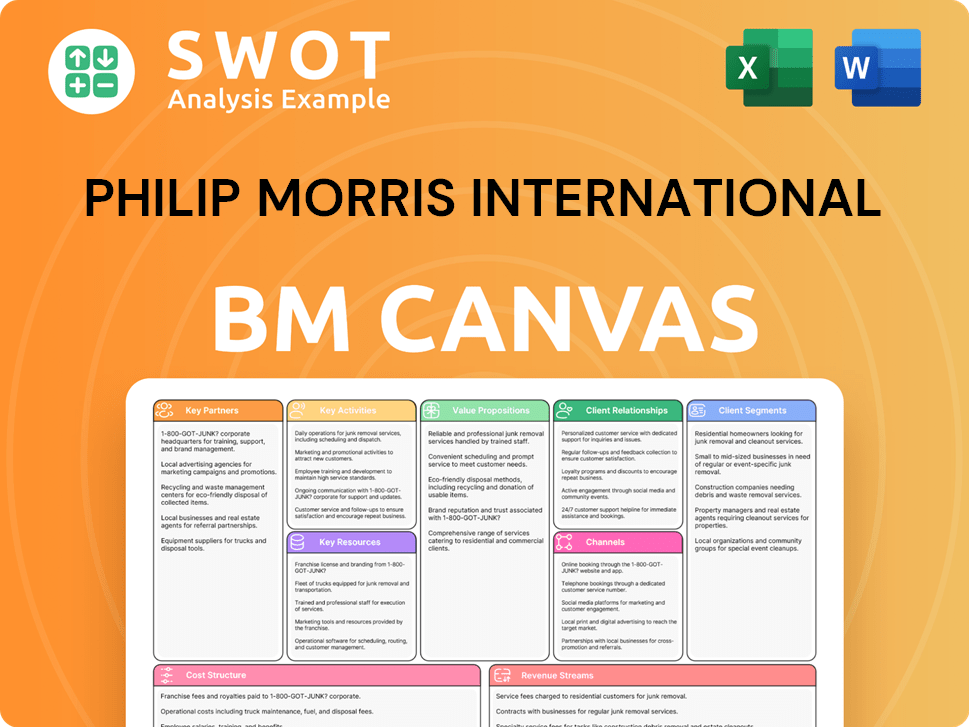
What is the Timeline of Key Events for Philip Morris International?
The PMI history is a story of evolution, marked by pivotal moments that reflect its adaptation to changing markets and consumer preferences within the tobacco industry. From its origins in London to its global presence, the company has navigated significant shifts, including the rise of iconic cigarette brands and a strategic pivot towards smoke-free products. This timeline showcases the key milestones in the company's journey.
| Year | Key Event |
|---|---|
| 1847 | Philip Morris opens his tobacco shop on London's Bond Street. |
| 1881 | Leopold Morris and Joseph Grunebaum establish Philip Morris & Company and Grunebaum, Ltd. |
| 1902 | The company is incorporated in New York by Gustav Eckmeyer. |
| 1919 | The American business is acquired and incorporated in Virginia as Philip Morris & Co., Ltd., Inc.; the Philip Morris coronet logo is introduced. |
| 1954 | Philip Morris (Australia) Ltd. is set up as the first major affiliate outside the U.S. |
| 1972 | Marlboro becomes the world's best-selling cigarette brand. |
| 1987 | Philip Morris International is incorporated as an operating company of Philip Morris Companies Inc. |
| 2008 | Philip Morris International spins off from Altria Group, becoming an independent public company focusing on international markets. |
| 2014 | PMI pilots IQOS, its first heat-not-burn product, in Italy and Japan. |
| 2021 | Jacek Olczak is appointed CEO, reaffirming the commitment to a smoke-free transformation. |
| 2022 | PMI acquires Swedish Match, a leader in oral nicotine delivery, including the ZYN brand. |
| 2024 (Q4) | Smoke-free business accounts for 40% of total net revenues. |
| 2025 (Q1) | Smoke-free products contribute 42% of total net revenues. |
PMI is focused on accelerating its transition to a smoke-free future. The company aims to be substantially smoke-free by 2030. Smoke-free products are expected to generate over two-thirds of total net revenues.
For 2025, the company anticipates adjusted diluted EPS in the range of $7.36 to $7.49, reflecting a 12% to 14% growth over 2024. Organic revenue growth is projected at 6% to 8%, and organic operating income growth at 10.5% to 12.5%.
PMI expects 178-181 billion units of smoke-free product volume in 2025, a 13% increase from FY24. This growth underscores the increasing consumer acceptance of smoke-free alternatives.
The company plans continued investments in ZYN capacity in the U.S. PMI is also looking to leverage its life sciences expertise. The goal is to enter adjacent healthcare and wellness markets, further diversifying its portfolio.
Philip Morris International Porter's Five Forces Analysis
- Covers All 5 Competitive Forces in Detail
- Structured for Consultants, Students, and Founders
- 100% Editable in Microsoft Word & Excel
- Instant Digital Download – Use Immediately
- Compatible with Mac & PC – Fully Unlocked
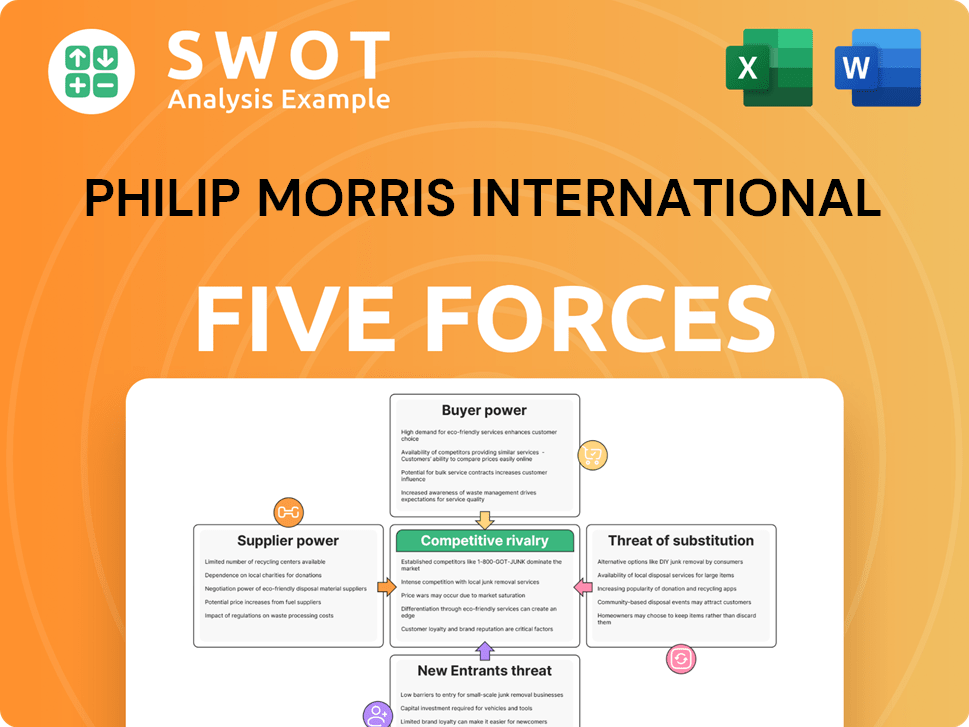
Related Blogs
- What is Competitive Landscape of Philip Morris International Company?
- What is Growth Strategy and Future Prospects of Philip Morris International Company?
- How Does Philip Morris International Company Work?
- What is Sales and Marketing Strategy of Philip Morris International Company?
- What is Brief History of Philip Morris International Company?
- Who Owns Philip Morris International Company?
- What is Customer Demographics and Target Market of Philip Morris International Company?
Disclaimer
All information, articles, and product details provided on this website are for general informational and educational purposes only. We do not claim any ownership over, nor do we intend to infringe upon, any trademarks, copyrights, logos, brand names, or other intellectual property mentioned or depicted on this site. Such intellectual property remains the property of its respective owners, and any references here are made solely for identification or informational purposes, without implying any affiliation, endorsement, or partnership.
We make no representations or warranties, express or implied, regarding the accuracy, completeness, or suitability of any content or products presented. Nothing on this website should be construed as legal, tax, investment, financial, medical, or other professional advice. In addition, no part of this site—including articles or product references—constitutes a solicitation, recommendation, endorsement, advertisement, or offer to buy or sell any securities, franchises, or other financial instruments, particularly in jurisdictions where such activity would be unlawful.
All content is of a general nature and may not address the specific circumstances of any individual or entity. It is not a substitute for professional advice or services. Any actions you take based on the information provided here are strictly at your own risk. You accept full responsibility for any decisions or outcomes arising from your use of this website and agree to release us from any liability in connection with your use of, or reliance upon, the content or products found herein.